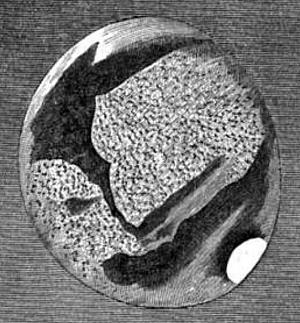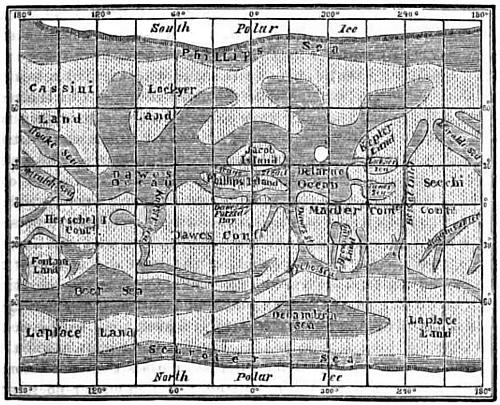 (source)
(source)
|
Camille Flammarion
(26 Feb 1842 - 3 Jun 1925)
French astronomer who studied double and multiple stars, the moon and Mars. He wrote popular books on astronomy, as well as novels.
|
[In this article from the late 19th century, the respected astronomer, Camille Flammarion, makes hypotheses about the nature of the surface of Mars (including plants, water, snow, rain) all of which are consistent with the observations that could be made at the time. Under the scientific method, these are valid hypotheses, because each is possible to be proved or disproved. Now that man has been able to send probes to Mars, and land data-collecting robots on the surface, we have the proof. Yes Flammarion missed the mark in much of what he supposed. Yet, his article remains interesting to read, as a stepping stone on the path of progress of science.]
Mars, by the Latest Observations
by Camille Flammarion
From La Nature
Translated from the French in Popular Science (1873)

[p. 197] In order successfully to observe Mars, two conditions are requisite: First, the earth's atmosphere must be clear at the point of observation; and, second, the atmosphere of Mars must be also free from clouds—for that planet, like the earth itself, is surrounded by an aërial atmosphere which from time to time is obscured by clouds just like our own. These clouds, as they spread themselves out over the continents and seas, form a white veil which either entirely or partially conceals from us the face of the planet. Hence the observation of Mars is not so easy a matter as it might at first appear. Then, too, the purest and most transparent terrestrial atmosphere is commonly traversed by rivers of air, some warm, some cold, which flow in different directions above our heads, so that it is almost impossible to sketch a planet like Mars, the image seen in the telescope being ever undulating, tremulous, and indistinct. I believe that, if we were to reckon up all the hours during which a perfect observation could be had of Mars, albeit his period of opposition occurs every two years, and although telescopes were invented more than two and a half centuries ago, the sum would not amount to more than one week of constant observation.
And yet, in spite of these unfavorable conditions, the Planet of War is the best known of them all. The moon alone, owing to its nearness to us, and the absence of atmosphere and clouds, has attracted more particular and assiduous study; and the geography (selenography rather [Selene, the moon]) of that satellite is now satisfactorily determined. That hemisphere of the moon which faces us is better known than the earth itself; its vast desert plains have been surveyed to within a few acres; its mountains and craters have been measured to within a few yards; while on the earth's surface there are 30,000,000 square kilometres (sixty times the extent of France), upon which the foot of man has never trod, which the eye of man has never seen. But, after the moon, Mars is the best known to us of all the heavenly bodies. No other planet can compare with him. Jupiter, which is the largest, and Saturn the fullest of curious interest, are both far more important than Mars, and more easily observed in their ensemble, owing to their size; but they are enveloped with an atmosphere which is always laden with clouds, and hence we never see their face. Uranus and Neptune are only bright points. Mercury is almost always eclipsed, like a courtier, by the rays of the sun. Venus alone may compare with Mars; she is as large as the earth, and consequently has twice the [p.188] diameter of Mars; besides, she is nearer to us, her least distance being about 30,000,000 miles. But, one objection is, that Venus revolves between the sun and us, so that, when she is nearest, her illuminated hemisphere is toward the sun, and we see only her dark hemisphere edged by a slight luminous crescent, or, rather, we do not see it at all. Hence it is that the surface of Venus is harder to observe than that of Mars, and hence, too, it is that Mars has the preëminence, and that in the sun's whole family he is the one with which we shall first gain acquaintance. The geography of Mars has been studied and mapped out. What principally strikes one on studying this planet is that its poles, like those of the earth, are marked by two white zones, two caps of snow, one of which is shown in the cut. Sometimes both of these poles are so bright that they seem to extend beyond the true bounds of the planet. This is owing to that effect of irradiation which makes a white circle appear to us larger than a black circle of the same dimensions. These regions of ice vary in extent, according to the season of the year; they grow in thickness and superficial extent around both poles in the winter, melting again and retreating in the summer. They have a larger extension than our glacial regions, for sometimes they descend as far as Martial latitude 45°, which corresponds with the terrestrial latitude of France.
This first view of Mars shows an analogy with our own planet, in the distribution of climates into frigid, temperate, and torrid zones. The study of its topography will, on the other hand, show a very characteristic dissimilarity between the configuration of Mars and that of the earth. On our planet the seas have greater extent than the [p.189] continents. Three-fourths of the surface of our globe is covered with water. The terra firma is divided chiefly into three great islands or continents, one extending from east to west, and constituting Europe and Asia; the second, situated to the south of Europe, in shape like a V with rounded angles, is Africa; the third is on the opposite side of the earth, and lies north and south, forming two V's, one above the other. If to these we add the minor continent of Australia, lying to the south of Asia, we have a general idea of the configuration of our globe.
It is different with the surface of Mars, where there is more land than sea, and where the continents, instead of being islands emerging from the liquid element, seem rather to make the oceans mere inland seas—genuine mediterraneans. In Mars there is neither an Atlantic nor a Pacific, and the journey round it might be made dryshod. Its seas are mediterraneans, with gulfs of various shapes, extending hither and thither in great numbers into the terra firma, after the manner of our Red Sea. The second character, which also would make Mars recognizable at a distance, is that the seas lie in the southern hemisphere mostly, occupying but little space in the northern, and that these northern and southern seas are joined together by a thread of water. On the entire surface of Mars there are three such threads of water extending from the south to the north, but, as they are so wide apart, it is but rarely [p.190] that more than one of them can be seen at a time. The seas and the straits which connect them constitute a very distinctive character of Mars, and they are generally perceived whenever the telescope is directed upon that planet.

The continents of Mars are tinged of an ochre-red color, and its seas have for us the appearance of blotches of grayish green intensified by the contrast with the color of the continents. The color of the water on Mars is therefore that of terrestrial water. But why is the land there red? It was at one time supposed that this tinge must be owing to the Martial atmosphere. It does not follow that, because our atmosphere is blue, the atmosphere of the other planets must have the same color. Hence it was permissible to suppose that the atmosphere of Mars was red. In that case the poets of that world would sing the praises of that ardent hue, instead of the tender blue of our skies. In place of diamonds blazing in an azure vault, the stars would be for them golden fires flaming in a field of scarlet; the white clouds suspended in this red sky, and the splendors of sunset, would produce effects not less admirable than those which we behold from our own globe.
But the case is otherwise. The coloration of Mars is not owing to its atmosphere; for, although the latter is spread out over the entire planet, neither its seas nor its polar snows assume the red tinge; and Arago, by showing that the rim of the planet's disk is of a less deep tinge than the centre, proved that the color is not due to the atmosphere. If it were, then the rays reflected from the margin to us would be of a deeper red than those reflected from the centre, as having to pass through a greater height of atmosphere. May we attribute to the color of the herbage and plants, which no doubt clothe the plains of Mars, the characteristic hue of that planet, which is noticeable by the naked eye, and which led the ancients to personify it as a warrior? Are the meadows, the forests, and the fields, on Mars, all red? An observer, looking out from the moon, or from Venus, upon our own planet, would see our continents deeply tinged with green. But, in the fall, he would find this tint disappearing at the latitudes where the trees lose their leaves. He would see the fields varying in their hues, and then would come winter, when they would be covered with snow for months. On Mars the red coloration is constant; it is observed at all latitudes, and in winter no less than in summer. It varies only in proportion to the clearness of the atmospheres of Mars and the earth. Still this does not preclude the supposition that the Martial vegetation has its share in producing the red hue of the planet, though it be principally due to the color of the soil. The land cannot be all over bare of vegetation, like the sands of Sahara. It is very probably covered with a vegetation of some kind, and, as the only color we perceive on Mars's terra firma is red, we conclude that Martial vegetation is of that color.
[p.191]We speak of plants on Mars, of the snows at its poles, of its seas, atmosphere, and clouds, as though we had seen them. Are we justified in tracing all these analogies? In fact, we see only blotches of red, green, and white, upon the little disk of the planet; but, is the red terra firma the green, water; or the white, snow? Yes, we are now justified in saying that they are. For two centuries astronomers were in error with regard to spots on the moon, which were taken for seas, whereas they are motionless deserts, desolate regions where no breeze ever stirs. But it is otherwise as regards the spots on Mars.
The unvarying aspect of the moon never exhibits the slightest cloud upon its surface, nor do the occultations of stars by its disk reveal even the slightest traces of an atmosphere. Contrariwise, the aspect of Mars is ever varying. White spots move about over its disk, very often modifying its apparent configuration. These spots can be nothing else but clouds. The white spots at its poles increase or diminish with the seasons, exactly like the circumpolar ice of earth, which, for an observer on Venus, would have the same aspect and the same variations as the polar spots of Mars have for us. Hence we conclude that these Martial white polar spots are masses of frozen water. Each hemisphere of Mars is harder to observe during its winter than during its summer, being often covered with clouds over its greater part. This would be precisely the aspect of the earth if observed from Venus. But what causes these clouds over Mars? Plainly nothing else but the evaporation of water. As for the ice, that is the same water frozen. But is the water there the same as here? Down to a few years ago, this question remained unanswered, but now it admits of a reply, thanks to the spectroscope, and the observations especially of Mr. Huggins.
The planets reflect the light they receive from the sun; on examining their spectra, we find the solar spectrum as though it had been reflected from a mirror. If we direct the spectroscope on Mars, we get, first of all, an image perfectly identical with that produced by the central star of our system. But, by the employment of more exact methods, Mr. Huggins found, during the last opposition of the planet, that the spectrum of Mars is crossed, in its orange portion, by a group of black lines coincident with the lines which appear in the solar spectrum at sunset when the sun's light passes through the denser strata of our atmosphere. Now, are these tell-tale rays produced by our atmosphere? To decide this question, the spectroscope was turned on the moon, which was at the time nearer the horizon than Mars. If the lines in question were produced by our atmosphere, they must have appeared in the lunar as well as in the Martial spectrum, and with greater intensity in the former. Yet they were not to be seen at all in the lunar spectrum; and hence it is plain that they are owing to the atmosphere of Mars.
The atmosphere of that planet, therefore, adds these special [p.192] characters to those of the solar spectrum, and this proves that the atmosphere of Mars is analogous to that of earth. But what is that atmospheric matter which produces these significant lines? From an examination of their positions, we find that they are not owing to the presence of oxygen, nitrogen, or carbonic acid, but to watery vapor. Therefore, there is water-vapor in the atmosphere of Mars, as in that of the earth. The green spots on its globe are seas—expanses of water resembling our seas. The clouds are made up of minute vesicles of water, like our own mists; and the snows consist of water solidified by cold. Furthermore, this water, as revealed by the spectroscope, being of the same chemical composition as terrestrial waters, we know that Mars possesses oxygen and hydrogen.
These important data enable us to form an idea of Martial meteorology, and to recognize therein a reproduction of the meteorological phenomena of our own planet. On Mars, as on earth, the sun is the supreme agent of motion and of life. Heat vaporizes the water of the seas, causing it to ascend into the atmosphere. This vapor assumes visible shape by the same processes which produce clouds here, i.e., by differences of temperature and of saturation. Winds arise in virtue of these same differences of temperature. We can observe the clouds on Mars as they are swept along by air-currents over the seas and continents, and several observers have, so to speak, photographed these meteoric variations.
If we are as yet unable precisely to see the rain falling on the plains of Mars, we can at least tell when it is falling, for we can see the clouds dispersing and gathering again. Thus there is on Mars, just as on earth, an atmospheric circulation, and the drop of water which the sun takes from the sea returns thither after it has fallen from the cloud which concealed it. And, although we must sternly resist any tendency to fashion imaginary worlds after the pattern of our own, still Mars presents to us, as in a mirror, such an organic likeness to earth, that it is hard for us not to carry our description a little further.
Thus, then, we behold, in space, millions of miles away, a planet very much like our own, and where all the elements of life exist, as they do here—water, air, heat, light, winds, clouds, rain, streams, valleys, mountains. To complete the resemblance, the seasons there are very much the same as here, the axis of rotation of Mars having an inclination of 27°, while that of the earth is 23°. The Martial day is forty minutes longer than the terrestrial.
In the face of all these facts, can we be content with the conclusions we have so far reached without going further, and considering ulterior consequences? If the same physico-chemical conditions are present on Mars as on earth, why should they not produce the same effects there as here? On earth the smallest drop of water is peopled with myriads of animalcules, and earth and sea are filled with countless [p.193] species of animals and plants; and it is not easy to conceive how, under similar conditions, another planet should be simply a vast and useless desert.—La Nature.
- Science Quotes by Camille Flammarion.
- 26 Feb - short biography, births, deaths and events on date of Flammarion's birth.
- Camille Flammarion Biography - article in McClure's Magazine (1894).
- The Flammarion Book of Astronomy, by Camille Flammarion. - book suggestion.
- Booklist for Camille Flammarion.




